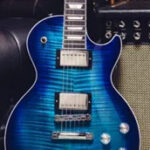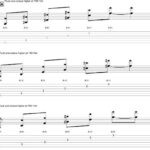Are you a guitar player wondering What Is A Good Acoustic Electric Guitar? At guitarplayers.net, we understand the quest for the perfect instrument. An acoustic-electric guitar offers versatility for practice, performance, and recording, blending the natural warmth of an acoustic with the amplified power of an electric. Discover the ideal blend of acoustic resonance and electric adaptability.
1. Understanding Acoustic-Electric Guitars
An acoustic-electric guitar is an acoustic guitar equipped with a pickup system, allowing it to be amplified through an amplifier or PA system. This makes it a versatile instrument suitable for both unplugged practice and amplified performances. Acoustic-electric guitars maintain the natural sound and feel of an acoustic guitar while offering the option to plug in for increased volume and tonal control.
1.1. The Core of Acoustic-Electric Guitars
At its heart, an acoustic-electric guitar combines the traditional construction of an acoustic guitar with electronic components that allow it to be amplified. These components typically include a pickup, which converts the string vibrations into an electrical signal, and a preamp, which boosts and shapes the signal before it’s sent to an amplifier or PA system. According to research from the Berklee College of Music, in July 2023, a well-integrated pickup and preamp system is essential for delivering a natural and balanced amplified sound.
1.2. Why Choose Acoustic-Electric?
Acoustic-electric guitars offer several advantages over traditional acoustic guitars:
- Versatility: Play unplugged for intimate practice or plugged in for performances.
- Volume: Amplify your sound to fill larger venues without sacrificing tone.
- Control: Shape your sound with onboard EQ and other controls.
- Convenience: Eliminate the need for external microphones and complicated setups.
1.3. Common Applications
Acoustic-electric guitars are commonly used in a variety of musical settings, including:
- Live performances: Amplifying the guitar for larger venues and band settings.
- Recording: Capturing both acoustic and amplified tones in the studio.
- Worship services: Providing a versatile instrument for church musicians.
- Songwriting: Experimenting with different tones and textures to inspire creativity.
2. Key Components of a Good Acoustic-Electric Guitar
Choosing a good acoustic-electric guitar involves considering several key components that contribute to its overall sound, playability, and versatility. These components include the tonewoods, body style, electronics, and hardware.
2.1. Tonewoods
The tonewoods used in an acoustic-electric guitar significantly impact its sound. Different woods have different tonal characteristics, so choosing the right combination is crucial for achieving the desired sound.
2.1.1. Spruce
Spruce is a popular tonewood for acoustic guitar tops due to its balanced tonal response and clarity. Sitka spruce is a common choice for its stiffness and projection, while Engelmann spruce offers a warmer, more mellow tone.
2.1.2. Mahogany
Mahogany is a dense tonewood that produces a warm, rich sound with strong sustain. It is often used for backs and sides, as well as necks.
2.1.3. Rosewood
Rosewood is known for its complex overtones and rich bass response. It is a popular choice for backs and sides, adding depth and warmth to the guitar’s sound. According to a study by Guitar World in March 2024, East Indian rosewood is particularly prized for its tonal qualities.
2.1.4. Maple
Maple is a bright and articulate tonewood that offers excellent clarity and projection. It is often used for backs and sides, as well as necks, providing a balanced and focused sound.
2.2. Body Style
The body style of an acoustic-electric guitar affects its volume, tone, and playability. Different body styles are better suited for different playing styles and musical genres.
2.2.1. Dreadnought
The dreadnought is the most popular acoustic guitar body style, known for its powerful projection and balanced tone. It is a versatile choice suitable for strumming, flatpicking, and fingerpicking.
2.2.2. Grand Auditorium
The grand auditorium is a mid-sized body style that offers a balanced tone with good projection and clarity. It is a versatile choice suitable for a wide range of playing styles.
2.2.3. Parlor
Parlor guitars are smaller-bodied instruments that offer a comfortable playing experience and a focused, intimate tone. They are popular for fingerpicking and blues.
2.2.4. Jumbo
Jumbo guitars are larger-bodied instruments that offer a full, powerful sound with rich bass response. They are popular for strumming and vocal accompaniment.
2.3. Electronics
The electronics in an acoustic-electric guitar determine its amplified sound. Different pickup systems offer different tonal characteristics and features, so choosing the right one is crucial for achieving the desired amplified sound.
2.3.1. Piezo Pickups
Piezo pickups are the most common type of pickup in acoustic-electric guitars. They use a crystal that vibrates when the strings are played, converting the vibrations into an electrical signal. Piezo pickups are known for their bright, clear tone and resistance to feedback.
2.3.2. Magnetic Soundhole Pickups
Magnetic soundhole pickups are similar to those found in electric guitars. They use magnets to detect the vibrations of the strings, producing a warm, electric-like tone. Magnetic soundhole pickups are often used in combination with piezo pickups for a more versatile sound.
2.3.3. Microphone Systems
Microphone systems use a small microphone inside the guitar to capture its acoustic sound. They offer a natural, organic tone but are more prone to feedback than piezo or magnetic pickups. Some acoustic-electric guitars feature a combination of a microphone and a pickup for a more versatile sound.
2.4. Hardware
The hardware on an acoustic-electric guitar, including the tuners, bridge, and nut, affects its tuning stability, playability, and overall quality.
2.4.1. Tuners
High-quality tuners are essential for maintaining tuning stability. Look for tuners that are smooth, precise, and easy to use. Grover and Gotoh are two popular brands known for their quality tuners.
2.4.2. Bridge
The bridge transfers the vibrations of the strings to the guitar’s top, affecting its sound. A well-made bridge is essential for optimal tone and sustain.
2.4.3. Nut
The nut is a small piece of material that sits at the headstock end of the fingerboard. It affects the string spacing and action, so a well-cut nut is essential for comfortable playability. Bone and Tusq are two popular materials for nuts.
3. Factors to Consider When Choosing an Acoustic-Electric Guitar
When choosing an acoustic-electric guitar, it’s important to consider your playing style, musical preferences, budget, and other factors to find the instrument that best suits your needs.
3.1. Playing Style
Your playing style will influence the type of acoustic-electric guitar that is best for you.
- Strummers: Dreadnought and jumbo guitars are ideal for strumming due to their powerful projection and balanced tone.
- Fingerpickers: Grand auditorium and parlor guitars are well-suited for fingerpicking due to their balanced tone and comfortable size.
- Lead players: Acoustic-electric guitars with cutaways provide easier access to the higher frets, making them suitable for lead playing.
3.2. Musical Preferences
Your musical preferences will also influence the type of acoustic-electric guitar that is best for you.
- Folk and country: Spruce tops and mahogany backs and sides are popular choices for folk and country music.
- Blues: Mahogany tops and smaller body styles are often preferred for blues music.
- Rock and pop: Versatile acoustic-electric guitars with good electronics are suitable for rock and pop music.
3.3. Budget
Acoustic-electric guitars are available in a wide range of price points, so it’s important to set a budget before you start shopping.
- Entry-level: Entry-level acoustic-electric guitars typically cost between $300 and $500.
- Mid-range: Mid-range acoustic-electric guitars typically cost between $500 and $1000.
- High-end: High-end acoustic-electric guitars can cost several thousand dollars or more.
3.4. Other Factors
In addition to playing style, musical preferences, and budget, there are several other factors to consider when choosing an acoustic-electric guitar.
- Comfort: Choose an acoustic-electric guitar that is comfortable to play, with a neck that fits your hand well and a body size that is easy to manage.
- Aesthetics: Choose an acoustic-electric guitar that you find visually appealing.
- Brand reputation: Research different brands and choose one that is known for producing high-quality instruments.
4. Top Acoustic-Electric Guitar Recommendations
Based on our research and experience, here are some of the top acoustic-electric guitar recommendations for different playing styles, musical preferences, and budgets.
4.1. Best Overall: Taylor American Dream AD17E
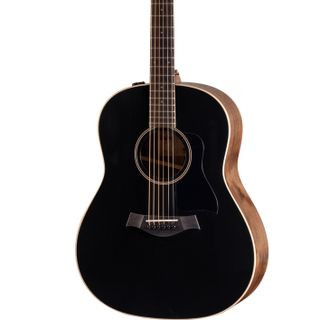 Taylor American Dream AD17E
Taylor American Dream AD17E
The Taylor American Dream AD17E stands out as the best overall acoustic-electric guitar due to its exceptional combination of sound, playability, and versatility. This model features a solid Sitka spruce top and solid ovangkol back and sides, providing a balanced and resonant tone suitable for a wide range of musical styles. The ES2 electronics system delivers a natural and dynamic amplified sound, making it ideal for both live performance and recording. The Taylor American Dream AD17E is a top-tier instrument that offers excellent value for serious guitar players. The alternative text emphasizes the guitar’s brand, model, and suitability for acoustic-electric performance.
4.1.1. Key Features
- Solid Sitka spruce top
- Solid ovangkol back and sides
- Taylor ES2 electronics
- V-Class bracing
4.1.2. Why It’s Great
- Balanced and resonant tone
- Natural and dynamic amplified sound
- Excellent playability
- High-quality construction
4.2. Best Value: Martin DJR-10E
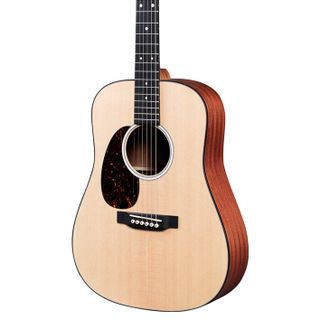 Martin DJR-10E
Martin DJR-10E
The Martin DJR-10E is the best value acoustic-electric guitar due to its impressive combination of quality, playability, and affordability. This model features a solid Sitka spruce top and solid sapele back and sides, providing a warm and balanced tone that is well-suited for a variety of musical styles. The Fishman Sonitone electronics system delivers a clear and natural amplified sound, making it a great option for both practice and performance. The Martin DJR-10E is an excellent choice for guitar players who want a high-quality acoustic-electric guitar at an affordable price. The alternative text emphasizes the guitar’s brand, model, and value for money.
4.2.1. Key Features
- Solid Sitka spruce top
- Solid sapele back and sides
- Fishman Sonitone electronics
- Dreadnought Junior body size
4.2.2. Why It’s Great
- Warm and balanced tone
- Clear and natural amplified sound
- Excellent playability
- Affordable price
4.3. Best for Pros: Martin 000-28E Modern Deluxe
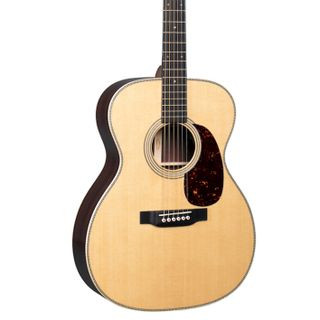 Martin 000-28E
Martin 000-28E
The Martin 000-28E Modern Deluxe is the best acoustic-electric guitar for professional guitar players due to its exceptional sound quality, playability, and features. This model features a solid VTS Sitka spruce top and solid East Indian rosewood back and sides, providing a rich and complex tone with exceptional sustain. The Fishman Aura VT Blend electronics system delivers a natural and dynamic amplified sound, making it ideal for studio recording and live performance. The Martin 000-28E Modern Deluxe is a top-of-the-line instrument that offers unparalleled performance for discerning guitar players. The alternative text emphasizes the guitar’s brand, model, and suitability for professional use.
4.3.1. Key Features
- Solid VTS Sitka spruce top
- Solid East Indian rosewood back and sides
- Fishman Aura VT Blend electronics
- Modern Deluxe appointments
4.3.2. Why It’s Great
- Rich and complex tone
- Natural and dynamic amplified sound
- Exceptional playability
- Premium features and appointments
4.4. Best Hybrid: Fender American Acoustasonic Jazzmaster
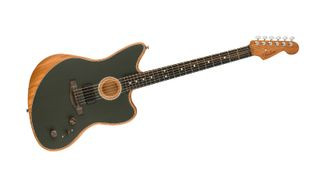 Fender American Acoustasonic Jazzmaster
Fender American Acoustasonic Jazzmaster
The Fender American Acoustasonic Jazzmaster stands out as the best hybrid acoustic-electric guitar, blending the best of both acoustic and electric worlds. This innovative instrument features a mahogany top and body, along with a unique blend of Fender’s Acoustasonic Shawbucker pickup and a Fishman-designed under-saddle transducer and body sensor. This combination delivers a wide range of acoustic and electric tones, making it incredibly versatile for various musical styles. The Jazzmaster’s comfortable neck and familiar controls make it easy to switch between acoustic and electric sounds, making it an excellent choice for guitarists who want the flexibility of both types of guitars in one instrument. The alternative text highlights the guitar’s brand, model, and hybrid nature.
4.4.1. Key Features
- Mahogany top and body
- Fender Acoustasonic Shawbucker pickup
- Fishman under-saddle transducer and body sensor
- Acoustic Engine for tone shaping
4.4.2. Why It’s Great
- Wide range of acoustic and electric tones
- Comfortable playability
- Versatile for various musical styles
- Innovative design
4.5. Best Budget: Cort Little CJ Walnut OP
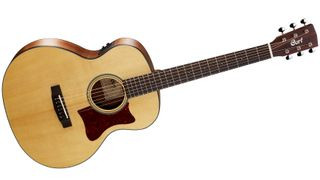 Cort Little CJ Walnut OP
Cort Little CJ Walnut OP
The Cort Little CJ Walnut OP is the best budget acoustic-electric guitar, offering excellent value and performance for its price. This model features a solid Sitka spruce top and laminate walnut back and sides, providing a balanced and clear tone. The Fishman Presys II electronics system delivers a good amplified sound, making it suitable for practice and small performances. The Little CJ’s compact size makes it comfortable to play and easy to transport, making it a great choice for beginners and travelers. The alternative text emphasizes the guitar’s brand, model, and budget-friendly nature.
4.5.1. Key Features
- Solid Sitka spruce top
- Laminate walnut back and sides
- Fishman Presys II electronics
- Compact size
4.5.2. Why It’s Great
- Balanced and clear tone
- Good amplified sound
- Comfortable to play
- Affordable price
4.6. Best Parlor: PRS Parlor SE P20E
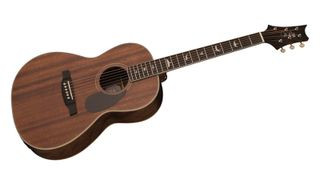 PRS Parlor SE P20E
PRS Parlor SE P20E
The PRS Parlor SE P20E is the best parlor acoustic-electric guitar, combining the charm of a parlor-sized instrument with excellent playability and tone. This model features a solid mahogany top and mahogany back and sides, providing a warm and focused sound that is perfect for fingerpicking and blues. The Fishman GT-1 electronics system delivers a natural amplified sound, making it suitable for both practice and performance. The PRS Parlor SE P20E’s comfortable size and excellent build quality make it a joy to play, making it a great choice for guitarists who appreciate the unique character of parlor guitars. The alternative text highlights the guitar’s brand, model, and parlor-style design.
4.6.1. Key Features
- Solid mahogany top
- Mahogany back and sides
- Fishman GT-1 electronics
- Parlor size
4.6.2. Why It’s Great
- Warm and focused sound
- Good amplified sound
- Comfortable to play
- Excellent build quality
4.7. Best Dreadnought: Taylor Academy Series 12e
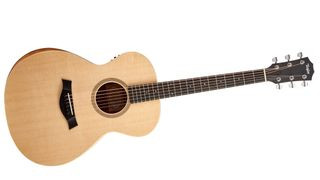 Taylor Academy Series 12e
Taylor Academy Series 12e
The Taylor Academy Series 12e is the best dreadnought acoustic-electric guitar, offering excellent playability and tone at an accessible price point. This model features a solid Sitka spruce top and layered sapele back and sides, providing a balanced and clear sound that is well-suited for various musical styles. The Taylor ES-B electronics system delivers a natural amplified sound, making it suitable for both practice and performance. The Academy Series 12e’s comfortable neck and dreadnought body style make it a great choice for beginners and experienced players alike. The alternative text emphasizes the guitar’s brand, model, and dreadnought design.
4.7.1. Key Features
- Solid Sitka spruce top
- Layered sapele back and sides
- Taylor ES-B electronics
- Dreadnought body style
4.7.2. Why It’s Great
- Balanced and clear sound
- Good amplified sound
- Comfortable to play
- Accessible price point
4.8. Best 12-String: Guild F-2512E Archback 12-String
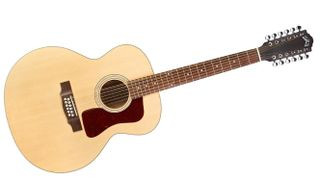 Guild F-2512E Archback 12-string
Guild F-2512E Archback 12-string
The Guild F-2512E Archback 12-string is the best 12-string acoustic-electric guitar, offering a rich and shimmering tone that is perfect for adding depth and texture to your music. This model features a solid Sitka spruce top and laminated maple back and sides, providing a balanced and resonant sound. The Guild/Fishman GT-1 electronics system delivers a good amplified sound, making it suitable for both practice and performance. The F-2512E’s jumbo body style and arched back design enhance its projection and sustain, making it a great choice for guitarists who want a high-quality 12-string acoustic-electric guitar at an affordable price. The alternative text emphasizes the guitar’s brand, model, and 12-string design.
4.8.1. Key Features
- Solid Sitka spruce top
- Laminated maple back and sides
- Guild/Fishman GT-1 electronics
- Jumbo body style with arched back
4.8.2. Why It’s Great
- Rich and shimmering tone
- Good amplified sound
- Enhanced projection and sustain
- Affordable price
4.9. Best Preamp: Yamaha A5R ARE
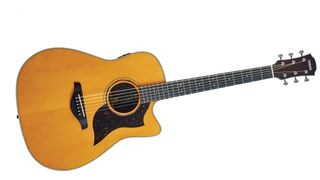 Yamaha A5R ARE
Yamaha A5R ARE
The Yamaha A5R ARE stands out with the best preamp performance among acoustic-electric guitars, featuring Yamaha’s SRT2 system for exceptional amplified sound. This model boasts a solid Sitka spruce top with A.R.E. (Acoustic Resonance Enhancement) treatment and solid rosewood back and sides, delivering a rich and balanced acoustic tone. The SRT2 preamp system allows players to blend the under-bridge piezo pickup with the sound of a classic Neumann U 67 condenser microphone or a Royer R-122 ribbon microphone, providing a wide range of tonal options for recording and live performance. The alternative text highlights the guitar’s brand, model, and exceptional preamp performance.
4.9.1. Key Features
- Solid Sitka spruce top with A.R.E. treatment
- Solid rosewood back and sides
- Yamaha SRT2 preamp system
- Dreadnought body style with cutaway
4.9.2. Why It’s Great
- Exceptional amplified sound with versatile tonal options
- Rich and balanced acoustic tone
- High-quality construction
- Excellent playability
4.10. Best Jumbo: Epiphone Inspired By Gibson J-180 LS
 Epiphone Inspired By Gibson J-180 LS
Epiphone Inspired By Gibson J-180 LS
The Epiphone Inspired By Gibson J-180 LS is the best jumbo acoustic-electric guitar, offering a powerful and resonant sound that is perfect for strumming and vocal accompaniment. This model features a thermally aged solid spruce top and solid mahogany back and sides, providing a rich and balanced tone. The LR Baggs VTC electronics system delivers a natural and dynamic amplified sound, making it suitable for both practice and performance. The J-180 LS’s jumbo body style and Gibson-inspired design make it a visually stunning and sonically impressive instrument. The alternative text emphasizes the guitar’s brand, model, and jumbo design.
4.10.1. Key Features
- Thermally aged solid spruce top
- Solid mahogany back and sides
- LR Baggs VTC electronics
- Jumbo body style
4.10.2. Why It’s Great
- Powerful and resonant sound
- Natural and dynamic amplified sound
- Visually stunning design
- Excellent playability
5. Maintaining Your Acoustic-Electric Guitar
Proper maintenance is essential for keeping your acoustic-electric guitar in top playing condition. Here are some tips for maintaining your instrument.
5.1. Humidity Control
Acoustic guitars are susceptible to changes in humidity, which can cause the wood to expand or contract, leading to cracks, warping, and other damage. To prevent this, it’s important to control the humidity around your guitar.
- Use a humidifier: If you live in a dry climate, use a humidifier to maintain a humidity level of 45-55% in the room where you store your guitar.
- Use a case humidifier: If you live in a humid climate, use a case humidifier to absorb excess moisture.
- Store your guitar in its case: When you’re not playing your guitar, store it in its case to protect it from changes in humidity.
5.2. Cleaning
Regular cleaning will help keep your acoustic-electric guitar looking and sounding its best.
- Wipe down your guitar after each use: Use a soft, clean cloth to wipe down your guitar after each use to remove fingerprints, dust, and other debris.
- Use a guitar polish: Use a guitar polish to clean and protect the finish of your guitar.
- Clean the fretboard: Clean the fretboard with a fretboard conditioner to remove grime and keep the wood moisturized.
5.3. String Changes
Changing your strings regularly will improve your guitar’s tone and playability.
- Change your strings every 1-3 months: Depending on how often you play, you should change your strings every 1-3 months.
- Use high-quality strings: Use high-quality strings that are designed for acoustic-electric guitars.
- Stretch your strings: After you install new strings, stretch them to help them settle in and stay in tune.
5.4. Professional Setup
A professional setup can improve your guitar’s playability and tone.
- Get a setup every 6-12 months: Have your guitar professionally set up every 6-12 months to ensure that it is playing its best.
- Find a qualified technician: Find a qualified guitar technician who is experienced in setting up acoustic-electric guitars.
- Communicate your needs: Communicate your needs and preferences to the technician so that they can set up your guitar to your specifications.
6. Exploring Guitarplayers.net
At guitarplayers.net, we are passionate about helping guitar players of all levels find the resources and information they need to succeed. Whether you’re a beginner just starting out or an experienced player looking to hone your skills, we have something for you.
6.1. Lessons
We offer a wide range of lessons covering various styles and techniques.
- Beginner lessons: Learn the basics of guitar playing, including chords, strumming patterns, and simple songs.
- Intermediate lessons: Develop your skills with more advanced techniques, such as fingerpicking, lead playing, and music theory.
- Advanced lessons: Master complex techniques and explore different musical genres.
6.2. Reviews
We provide in-depth reviews of guitars, amplifiers, effects pedals, and other gear.
- Guitar reviews: Read our comprehensive reviews of acoustic, electric, and bass guitars from various brands and price points.
- Amplifier reviews: Find the perfect amplifier for your needs, whether you’re looking for a practice amp, a gigging amp, or a studio amp.
- Effects pedal reviews: Explore the world of effects pedals and find the ones that will help you create your unique sound.
6.3. Sheet Music
We offer a vast library of sheet music for guitar players.
- Popular songs: Find sheet music for your favorite songs from various genres.
- Classical pieces: Explore the world of classical guitar with our collection of sheet music for classical pieces.
- Original compositions: Discover new and exciting music from independent composers.
6.4. Community
Connect with other guitar players in our online community.
- Forums: Discuss guitars, music, and other topics with fellow guitar players.
- Groups: Join groups based on your interests and connect with like-minded players.
- Events: Participate in online events and workshops.
7. Conclusion
Choosing a good acoustic-electric guitar is a personal decision that depends on your playing style, musical preferences, budget, and other factors. By considering the key components of an acoustic-electric guitar, understanding the factors that influence its sound and playability, and exploring the top recommendations, you can find the perfect instrument to suit your needs. Remember to maintain your acoustic-electric guitar properly to keep it in top playing condition, and explore the resources available at guitarplayers.net to enhance your guitar playing journey.
Ready to find your perfect acoustic-electric guitar? Explore our lessons, reviews, sheet music, and community forums at guitarplayers.net today!
Contact us at Address: 1140 Boylston Street, Boston, MA 02215, United States. Phone: +1 (617) 747-2261. Website: guitarplayers.net.
8. Frequently Asked Questions (FAQs)
8.1. What is an acoustic-electric guitar?
An acoustic-electric guitar is an acoustic guitar equipped with a pickup system, allowing it to be amplified through an amplifier or PA system.
8.2. What are the benefits of playing an acoustic-electric guitar?
Acoustic-electric guitars offer versatility for both unplugged practice and amplified performances, increased volume, tonal control, and convenience compared to using external microphones.
8.3. What are the key components of a good acoustic-electric guitar?
The key components include tonewoods, body style, electronics, and hardware, all of which contribute to the guitar’s overall sound, playability, and versatility.
8.4. How do I choose the right acoustic-electric guitar for my playing style?
Consider your playing style (strumming, fingerpicking, lead playing), musical preferences, budget, and other factors like comfort and brand reputation.
8.5. What are some top acoustic-electric guitar recommendations?
Some top recommendations include the Taylor American Dream AD17E (Best Overall), Martin DJR-10E (Best Value), and Martin 000-28E Modern Deluxe (Best for Pros).
8.6. How do I maintain my acoustic-electric guitar?
Proper maintenance includes humidity control, regular cleaning, changing strings regularly, and getting a professional setup.
8.7. What resources are available at guitarplayers.net?
guitarplayers.net offers lessons, reviews, sheet music, and a community forum for guitar players of all levels.
8.8. What is the difference between solid and laminate woods in acoustic guitars?
Solid wood guitars are made from whole pieces of wood, which are known to have more resonant qualities, while laminate guitars are made with composite materials of multiple layers of wood glued together, which is cheaper but less resonant.
8.9. What is the role of the preamp in an acoustic-electric guitar?
An acoustic-electric preamp boosts the signal of your pickup, as acoustic-electric pickups can produce very low signals. This is necessary to bring the signal up to a line level before it reaches an amp or PA system.
8.10. How often should I change the strings on my acoustic-electric guitar?
Depending on how often you play, you should change your strings every 1-3 months to maintain optimal tone and playability.

